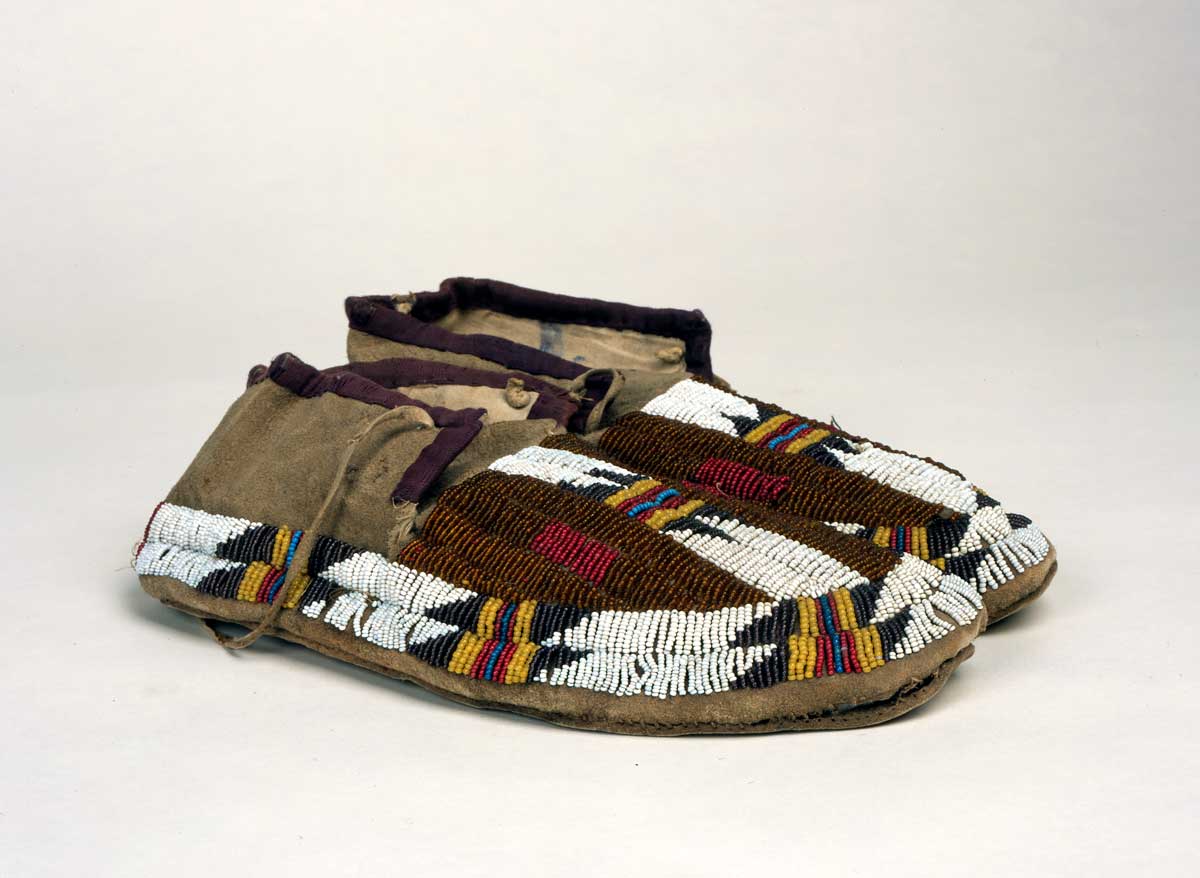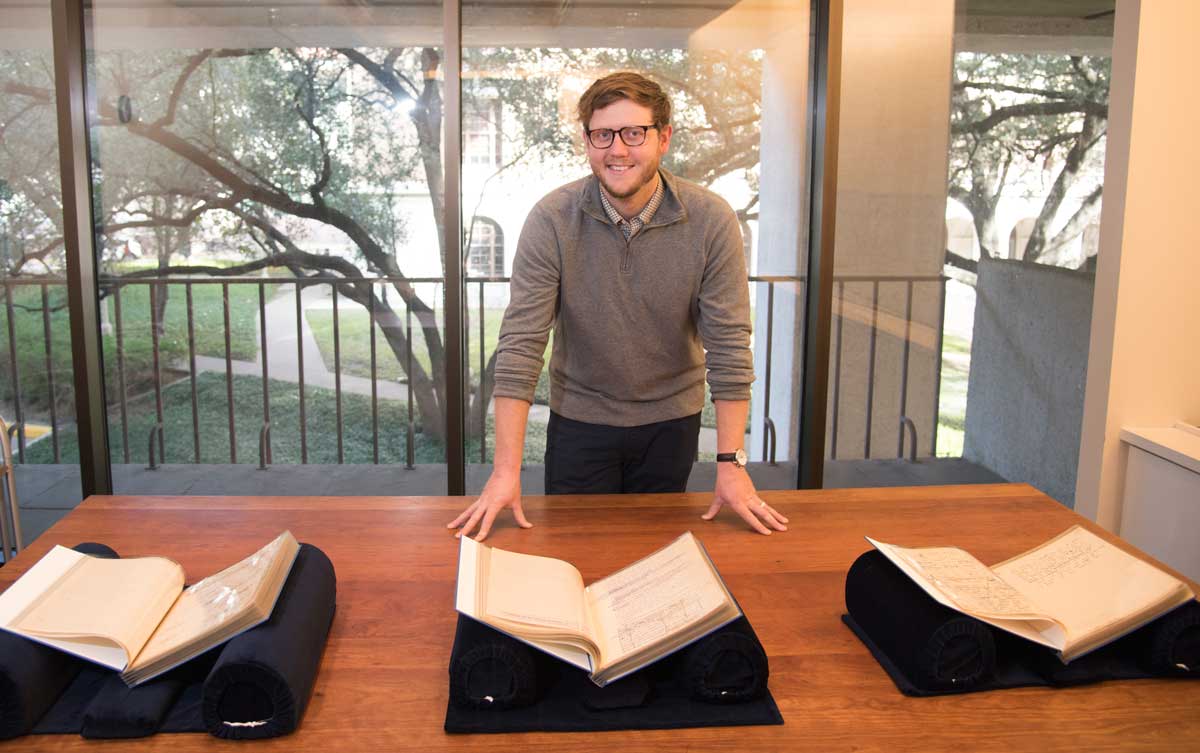“Tell me why you think this is in the room,” I ask, pointing to a pair of delicately beaded moccasins on the lower shelf of the display case.
After facilitating several class visits to the Ransom Center, I’m not surprised by the silence that follows. Many of the students’ faces seem to say, “Wait, isn’t that your job?”
It is, of course. Which is to say, there is always a logic to the materials in the cases and on the tables; always some connection to the course’s methods and matter. That’s the unspoken contract between us, the terms of the whole enterprise: I provide content; they provide attention and, if I’m lucky, interest. In asking the question I am, ostensibly, breaking this contract.
The expectations I’ve disrupted are largely borne out by students’ academic experiences: generally, you do the reading, attend the lectures, and hope to absorb enough data to perform well on the exam. Correspondingly, most students (and even some professors) who visit the archives expect to be walked through a selection of significant objects; to be provided with content. This is a reasonable expectation, considering many of their first experiences with cultural institutions like the Ransom Center are with curated public exhibits.
But there are no exams here, and it’s the rare professor who provides assessment based on a single day’s visit. Archival education is often, to borrow the expression, all carrot and no stick. You hope to display objects that evoke a strong response: discovery, curiosity, even occasionally disgust. There’s a showmanship to it that can be addictive: “And behind this curtain, you’ll find Arthur Conan Doyle’s collection of ghost photographs! Step right up and see Radclyffe Hall’s prize-winning dachshunds!” You hope for the collective gasp, laugh, or groan. Many times, you even get it.
After a while, however, you begin to wonder what the students really take away from these experiences.
As archival educators, we often work hard to re-create the excitement of the archives, the magic moment of discovery. Maybe this impulse proceeds from our awareness of the extensive, often frustrating labor behind these discoveries: archival research is many things, but rarely is it glamorous. We instinctively fear the frustration that might cut off a student’s engagement with research before it can begin. Further, as scholars and library staff we are trained to offer results, to provide answers, draw connections. We are experts, after all: our primary language is expertise.
As educators, however, we are responsible not only for providing answers, but for generating good questions. I went in search of ways to help students experience, however briefly, what it is like to be faced with an unfamiliar object and begin the labor of making meaning from it—in other words, what it is like to be a researcher. I had discussions with colleagues about what flipping the classroom might look like in a special collections setting.

After an appropriate period of silence, I reveal that the moccasins in question belonged to the English modernist writer D. H. Lawrence. The class hasn’t read any Lawrence, but they have just finished Aldous Huxley’s Brave New World, a manuscript draft of which is also displayed on a nearby table. After identifying the shoes’ owner (I am not so cruel as all that), I invite a group of students to see what they can find in a few minutes of research on their phones.
They soon report a wealth of details: that Huxley and Lawrence had been close friends; that Huxley had visited Lawrence in New Mexico; that Huxley had edited the first volume of Lawrence’s letters. One student wonders out loud whether the famous reservation scenes of Brave New World, or the character “John the Savage,” might have been based on Huxley’s visit. Another raises questions regarding cultural appropriation, and what role the Native American communities Huxley and Lawrence visited might have had in the production of this famous novel. This soon branches into a discussion of other collection materials: manuscripts, paintings, and photographs in the D. H. and Frieda Lawrence collections, the J. Frank Dobie and Anita Brenner papers, western art by Frank Reaugh.
Some of these results I had anticipated, others I couldn’t have foreseen. It doesn’t always go this well, but then, neither does research: dead ends are inevitable—maybe even invaluable— in the production of knowledge. In any case, the moccasins make a useful “cold open” for the session. Seeing what kinds of questions they might bring to even a well-worn pair of shoes, the students’ engagement with the somewhat less inscrutable drafts, letters, and photographs displayed around the room quickly becomes animated, as different groups look up names, compare originals, decipher handwriting, and prepare to present “their” object to the rest of us.
Students are occasionally frustrated when I employ this approach, but more often they express surprise at what they’ve been able to find on their own. The thrill of discovery is still there, and I’ll admit to reserving a few choice anecdotes to keep the discussion moving, but as with most skills, it seems that engaging with a process yields more tangible results than being presented with a product.
Top image: Typescript page from Aldous Huxley’s draft of Brave New World.

